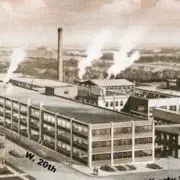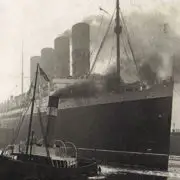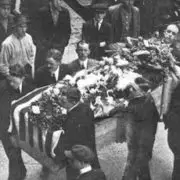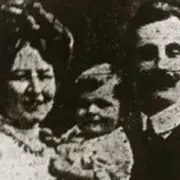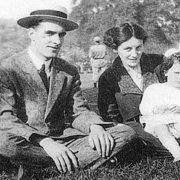The Lusitania : Part 7 : Passengers of Distinction
“When G.E. Co. claims Bob, the electrical world may expect a shock.”
……Cornell, 1904
That jocular prediction came from Robert Rankin’s Cornell class year book. He was born on March 23, 1882, as the first-born son born of George and Sarah Rankin of Ithaca, New York. Rankin was fascinated by electricity, and upon graduating high school he enrolled at Cornell University. When he was not studying, he was actively involved in sports, which resulted in multiple scholarships; so many, in fact, that his friends joked that he was bankrupting the Cornell treasury.
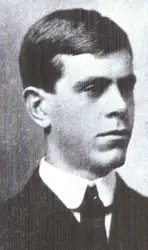
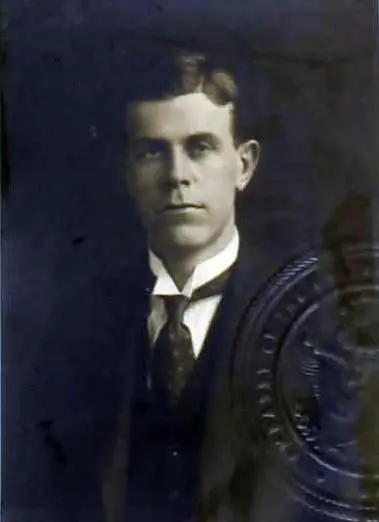
Robert Rankin
Rankin began working for Westinghouse soon after college, all the while experimenting with electromagnets and their properties. He was hired by the San Paolo Electric Co., of Brazil, which meant frequent travel.
He met socialite Enid Scott on a voyage to South America. Enid’s father was Simon Scott, a New York merchant and art collector. She and Robert married the following year.
Robert Rankin became friends with Dr. Frederick Stark Pearson, owner and manager of Pearson Engineering Corporation. Rankin’s professional dealings and friendship with Dr. Pearson led him to take the Lusitania on her last voyage. The Doctor and his wife had already booked passage, and recommended to Rankin that he should make the crossing as well.
May 1st was a dull, overcast day and Rankin did not wish to linger on deck. He was led down a maze of corridors to inside cabin E-43.
Mr. Rankin found his table companions for the voyage agreeable, and became fast friends with Clinton “Bill” Bernard, who told him that he was on his way to Greenland on a geological expedition. Rankin also spent time with the Pearsons, Robert Dearbergh, and Thomas Bloomfield.
The afternoon of the 7th was a clear, sunny day and at about noon, Rankin went to the writing room to write a long letter to his wife. Dr. Pearson passed through while he was writing, and stopped to talk with him. They discussed the sudden alteration in the ship’s course. Robert Rankin later said, “The ship turned northward from the course she had been holding making a huge semicircle and heeling well over to port.” The letter finished, he took a quick walk along the boat deck before lunch. He saw Fred and Mabel Pearson taking a stroll as well.
Robert Rankin was standing on the starboard side at some point after 2 pm, with Thomas Bloomfield and Robert Dearbergh, when one of them caught a glimpse of something unusual. “There’s a whale,” he heard. Looking out onto the dazzling blue sea, he knew at once what the black ridge was. A white, foamy streak shot out from the submarine.
“It looks like a torpedo,” Dearbergh exclaimed.
“My God, it is a torpedo,” said Bloomfield.
The three watched, as it cut through the water. Rankin described the excitement of the moment in great detail:
It came straight for the ship. It was obvious it couldn’t miss. It was aimed ahead of her and struck under the bridge. The explosion came with a terrific crash, clear through the five decks destroying the boiler room and the main steam pipe….A mass of glass, wood, etc came pouring on our heads, 200 feet aft. We ducked into the smoking room shelter and I never saw my companions again.
Robert Rankin believed from the start that the Lusitania was doomed. He crossed the smoking room to the portside, where he aided some men who were trying to push a lifeboat over the edge. But he thought that it was a useless task, for the ship was listing too far to starboard, and he abandoned this effort. He entered the companionway and made his way down, trying not to bump into the people who were rushing up the stairs. He got as far as D deck and heard the disconcerting sound of water very close to where he stood. Looking down, he saw that E deck was already flooding. He crossed the darkened passageway on D deck to a porthole, and to his horror, saw that the water was within twelve inches of the port.
Rankin came across Clinton Bernard in the stairwell. Bernard asked him, “Have you a life preserver?” to which he shook his head, “No.” They tried a few cabins, but found that the life vests were gone. The two decided that if they found one, they would share it, “fifty-fifty.”
The two friends found quite a few passengers milling about and waiting to be told what to do, as they walked along B deck. They mounted the stairs to A deck and watched the crew beginning to load boats along the starboard side. Boat # 1 drifted away with what appeared to be just one person aboard, to their dismay,. Rankin came across one of those “doughnut life preservers” attached to the rail and presented it to Bernard. They prepared to jump overboard with it when a steward approached them and claimed that there was an old lady who needed it. The gentleman unselfishly gave it away.
The last minutes were a blur to Rankin:
By this time the boat was sinking rapidly and Bernard said, ‘Goodbye old chap’ and grabbed me by the hand at the same time pulling out his money and throwing it away. The sixty foot deck was, by now, within six to ten feet of the water and I pulled off my coat and jumped, feet first, as far as I could and started to swim on my side. Looking straight up I saw the funnels coming over and thought that I would certainly be hit on the head. Then the funnels went back and the bow plunged and the ship went down.
The water felt like ice to Rankin. He noticed that he was covered with a layer of soot from the funnels. He swam to boat #11, which was packed with more than sixty people. The assistant deck steward pulled him in, despite the crowding. Boat #11 drifted with the tide and wind, for it had no rudder. Finally, the Wanderer, of Peel, came to the rescue and pulled them aboard. They were later transferred to the Flying Fish and taken to Queenstown.
The arrival at Queenstown was striking, as the wet and weary survivors walked between a line of townspeople. The crowd cheered and applauded as they made their way forward. Rankin felt a lump in his throat as the magnitude of the tragedy hit him. A “jacky-tar” gave him a drink of hot whiskey and put him to bed.
The next day, he made his way through the town looking for his friends. He found Clinton Bernard, who had swum to a collapsible and rescued many people, among them Stanley Lines and Dorothy Conner. Rankin found Dr. Pearson lying in a makeshift morgue and arranged for his embalming. Rankin and another shipboard acquaintance, Robert Timmis, motored over to Kinsale the Sunday after the disaster to help identify bodies, but found no one that they knew.
He gave a brief description of his experiences to the American Counsel, which was sent to the State Department in the form of a deposition:
At 12 pm ship began zigzag course off Irish coast. Walked deck till 1:30. Went to lunch 20 minutes. Arrived on rear starboard A Deck at about 2:00 pm, ships time of night before. At exactly 2:10 pm one of our group of four sighted submarine rising about 1/4 mile to starboard bow. Lusitania going slow all morning. Had been blowing fog horn till about 10:00 am and was still going about 15 knots. Torpedo left submarine almost instantly after sighted and traveled rapidly toward boat, leaving white trail. Struck ship not far from a line below the bridge and through boiler room. Explosion tore through deck, destroying part of forward lifeboat. A boiler exploded immediately. There was no second torpedo. Boat listed immediately and began to fill through open ports as well as the hole caused by explosion. Ship sank at 2:33 by watch of passenger who jumped in sea. Torpedo fired without warning and while most of passengers were below at breakfast.
Mr. Rankin arrived in London on Monday afternoon, intent on keeping his business appointments, although he had lost all his papers. He returned to the United States aboard the St. Louis, along with survivors Oscar Grab and Charles Hardwick; they arrived in New York on June 7, 1915.
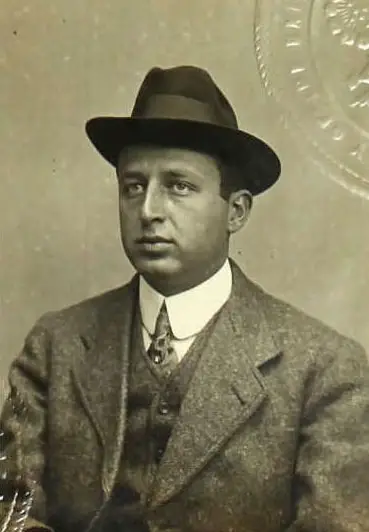
Oscar Grab
The Lusitania disaster did not deter Rankin from traveling. He left San Paolo Electric, and he and his wife moved to Peking, China where he was appointed vice president of both Anderson Meyer and Co and the Willard Straight Co. He also served as the director of the Chinese American Bank of Commerce. Relations between Robert and Enid deteriorated, and they separated and then divorced. His ex-wife moved back to New York and wrote a book titled Dominions of the Air. It examined the causes of war and offered suggestions on preventing future wars. She passed away a few years later at age forty-three. Apparently Rankin and Enid adopted a Chinese child named Peter, but he is not mentioned in either of their obituaries.
Robert Rankin retired in 1920 and began traveling, to relax and to forget about his failed marriage. He met a woman named Hilda Master Rigby and they were wed on February 24, 1923. They settled in Angmering on Sea, Sussex, England.
Robert Rankin filed a claim for compensation for lost effects and was awarded $1,362.00.on February 21, 1924.
The Rankins moved to St. Catherine’s, Ontario, where they remained for many years. Robert became a father, at age fifty-two, to a girl who they named Virginia. He went to Washington, D.C. during World War II, to work as an engineer for US Government, and he became a technical adviser to Evans International Corp after the war. Robert eventually returned to retirement back in St. Catherine’s, Ontario. He began vacationing in Provincetown, Massachusetts in old age, where he could, no doubt, look back and smile at life filled with promise well realized. Mr. Rankin passed away in Provincetown on August 10, 1959 at age 76.

